
Are you interested in show jumping? It might seem a bit overwhelming going through all the pages of rules and regulations, looking for tack, getting the right fit, and starting your showjumping career. Luckily we have you covered. In this blog, we will be doing a full, in-depth checklist for you and your horse, covering what you need to know and what you need to start showjumping.
The basic checklist for tack needed for showjumping includes a Jumping Saddle, girth, stirrups, saddle pad, bridle, bit, boots, martingale, rider gear, and most importantly, a horse. There are hundreds of Equestrian brands and types of tack, but you will need to know what types, brands, and dimensions are allowed in the showjumping competitions. Not all of the tack will suit your horse either, as each horse has its own preferences.
Each piece of tack on your horse will and has to perform a basic function. Be it bits, bridles, girths, or stirrups, each has its own functions, and each horse and rider has their own preference. The tack combined needs to ensure that the horse and rider are still comfortable, safe, and controlled.
Combining different types of tack will give different results. In our checklist, we will look at the individual functions of each piece of necessary tack and what type of horses it will suit. Some horses are very picky, and some horses don’t really care what you ride them in, as long as it does not cause harm, discomfort, or pain.
Tack Needed For Show Jumping
Bits
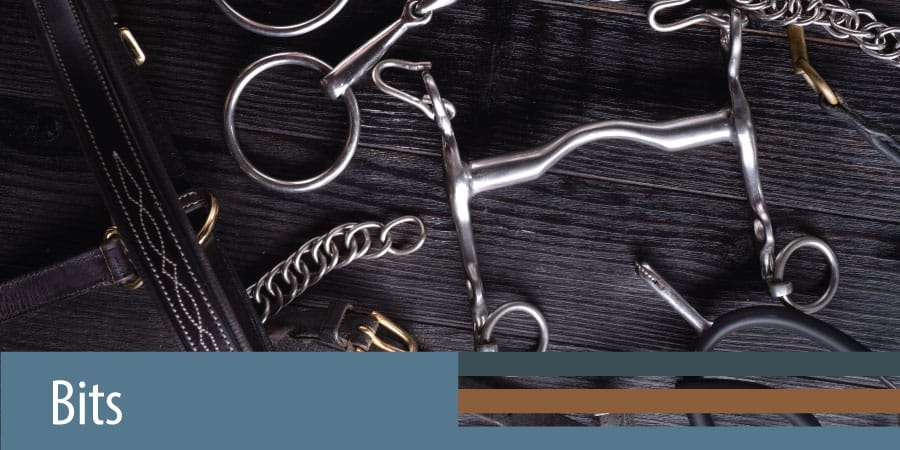
Function
A bit is a piece of metal, alloy, plastic, or rubber designed to be in the horse’s mouth and connect to the reins. The main function of the bit is to control and steer the horse. The bit focuses on pressure points in the mouth to give the rider the ability to ask the horse to turn, stop, slow down, speed up, lower, or raise their head.
The pressure points or sensitive parts are the tongue, bars, corners of the mouth, and palate. Bits come in all kinds of shapes and sizes. Some are soft and light, some are more direct and hard. Each horse has a unique mouth and preference for the type of bit. Your horse will tell you how they feel about the bit through body language and behavior.
The rider and trainer should seek a bit in which the horse is comfortable, relaxed, and responsive. The rider needs to have a firm but flexible and soft contact and not feel the need to pull or hang in the horse’s mouth. The jaw muscles and tongue is connected to the rest of the horse’s body through a series of connective tissue and muscle. If the horse is stiff and uncomfortable with the bit, the rest of the horse’s body will feel stiff. This will also hinder the horse from performing at its best.
If the horse likes the bit, they will have a relaxed jaw, lick and chew, produce saliva, and have a relaxed body posture. The horse will feel responsive and ‘soft’ In the rider’s hands. The horse will work freely and have movement throughout its whole body. The horse will relax the neck, back, and rump muscles and work in a correct frame with good posture, balance, and free movement.
Different kinds allowed in show jumping
There are not many rules in the FEI book regarding bits, except for pony riders. Most bits are allowed at events unless they are deemed harmful to the horse by the ground jury and veterinarian.
For pony riders
The material from which the bit is made does not matter; the bit must be in its original manufactured state. No double bridles are allowed for pony riders, and the bit’s diameter may not be smaller than 10mm. Bits that are not allowed in any show jumping competition: wire, double wire, or chain bits – these bits cause a lot of pain and discomfort for the horses due to their design and are thus deemed abuse.
The bits that are allowed by the FEI
- All snaffle bits, this includes solid, single or double jointed, curved or soft twist.
- All gags, this includes normal snaffle gags, jointed, unjointed.
- All Pelham, this includes jointed, double-jointed, solid, and soft twist
- The length of the “checks” must not exceed 15cm
- The rein must be connected to either the main ring of the bit or both rings through a rein connector
- Only one rein is allowed
- All kimberwicks
- Smooth, snaffle Pessoas, this includes jointed, double-jointed and solid
- Only a maximum of 4 rings are allowed
- The rein can be attached to any one of the rings. A rein connector may be used or double reins.
- The length of the checks may not exceed 16cm
- Hackamores (bitless bridles)
- The length of the checks may not exceed 17cm. The measurement is done in a straight line from the middle of the top ring to the middle of the bottom ring.
- The hackamore may not be used in conjunction with a bit
Read this article for more on jumping in a bitless bridle
How these bits work
Snaffles
Snaffle bits are the most basic and widely used bits in the equine world, as most horses like them. Snaffles are made with rubber or sweet metals that are alloys. The “sweet” metals are used to encourage the horse to salivate more. This makes them swallow frequently and allows them to relax their jaw.
Through a relaxed jaw, the horse will be more relaxed through its body. The snaffle is considered a mild bit, and the basic structure is the same for all of them except for small differences, which modify the action. The basic is a straight or jointed mouthpiece with rings on each side.
The side rings can be loose. These slide through the mouthpiece, D-rings or egg but rings, which is more solid and does not move, of extended pieces like fulmars, full cheeks, and dropped cheeks, these pieces apply pressure on the sides of the mouth to aid in turning the head.
The difference between jointed, double jointed and solid types
Jointed snaffles have a single link in the middle of the mouthpiece. When pressure is applied through the reins, the mouthpiece’s outer sides will press down onto the bars of the mouth, and the joint will push upwards in a “nutcracker” motion. This clothe applies pressure onto the palate of the mouth and ‘pinches’ the tongue.
Double-jointed snaffles have two joints with a plate, oval-shaped piece, or rings in the middle. It applies pressure more evenly and does not have a nutcracker effect on the mouth when pressure is applied to the sides pieces. The middle joint serves different purposes.
Depending on the type, a plate will either lie flat on the tongue and apply even pressure or lie upward across the tongue with the thin part of the plate applying pressure onto the tongue, creating a sharper aid. An oval-shaped joint – like a French link – is milder than the angered plate and concentrates pressure on the rounder part onto the tongue.
The rings on the jointed part will allow a horse to “play” more with its tongue. This is effective with horses that set their jaw against the bit and encourage them to relax their jaw.
Solid mouthpieces are just bits with one solid bar running through the mouth and over the tongue. The solid piece can be straight or curved, thick or thin. Even for jointed bits, a thinner mouthpiece is sharper and more exact when pressure is applied, whereas the thicker mouthpieces spread the pressure more evenly. A thicker mouthpiece is more suitable for horses with smaller tongues, thin bars, and high palates.
Gags
A gag bit is a type of modified snaffle to apply more pressure onto the horse’s poll instead of just focusing on the mouth.
Pelham
A Pelham is a stronger bit due to its combination of actions. A Pelham can have a solid
Kimberwicks
Pessoas
Hackamores
Read this article for more on jumping in a hackamore.
Recommendations
I will be focusing on bit brands for recommendations because each horse prefers a different design and type of bit. Using the horse’s conformation of their mouths and their personalities, one can choose the right bits or your horse. If your horse is very sensitive in the mouth, it may be an option to go bitless. For more info on bitless bridles, check out our other blog post:
- Bomber
- Myler
- Sprenger
- Stubben
- Happy Mouth
Bridles
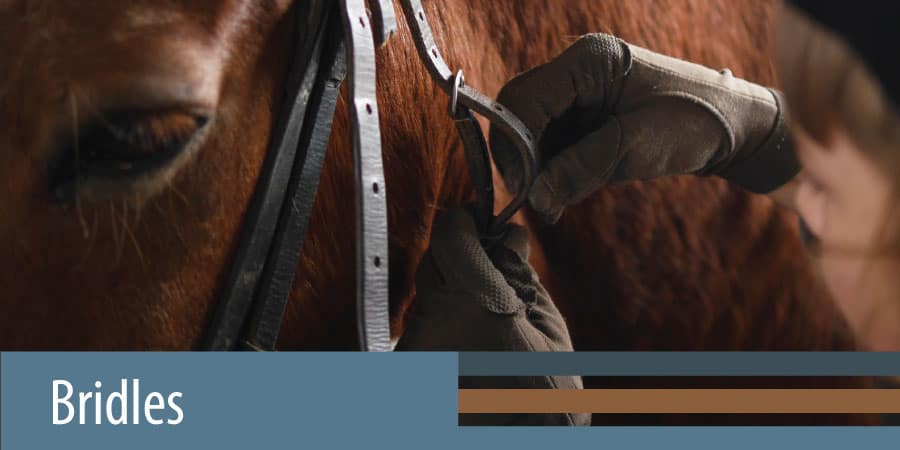
Function
The main function of a bridle is to control the horse. The bridle holds the bit in the horse’s mouth, and in conjunction with ten bit, it is used to direct the horse. Bridles have different designs, and one part of the bridle in particular changes in style a lot and serves different purposes: the noseband.
Bridles are made out of leather or synthetic material. There are six sizes: mini, Shetland, pony, cob, full and extra full. A cob size bridle fits most thoroughbred, and warmblood horses and extra full bridles are made to fit draft horses to give you an indication.
Different kinds allowed in show jumping
There isn’t much focus on the bridles themselves but rather on the nosebands as the bit and nosebands work together to help the rider control the horse. In one rule, it is set out that the reins must be attached to the bit or directly to the bridle.
Two pairs of reins are allowed, and one pair must be directly attached to the bit or bridle. Draw reins are forbidden in and during the competition and are only allowed in parades and prize-giving ceremonies.
Most regulations on nosebands are set out under the pony riders segment in the FEI rule book. The noseband must be flat and made from leather. In the case of a crossed/Mexican noseband, a disc of sheepskin may be used at the intersection.
Nosebands used in competition and how they work:
Cavesson noseband
This is the most widely used and common type of noseband used at it is a simple noseband. The cavesson noseband does not have any attachments and sits 1 to 2 inches below the facial crest. The noseband must fit loose enough for a minimum of two fingers between the noseband and the bony part of the nose.
The noseband function is to help prevent the horse from opening its mouth. It suits the type of horse that is not fussy and easily accepts the contact.
Dropped noseband
A dropped noseband has a similar design to the cavesson. The dropped noseband sits lower on the horse’s face and mainly encircles the mouth. The strap underneath sits in the chin groove, and it sits in front of the bit. The top of the drop noseband must still sit on top of the bony part of the nasal and not on the soft cartilage.
The function is the same as the cavesson, but it sits closer to the mouth; thus, it is more direct, and it also helps prevent the horse from crossing its jaw.
Flash
A flash is a variation of the cavesson where it has an added attachment. It has a thin leather strap connected to the noseband and is designed to go around the horse’s mouth, under the chin groove, and in front of the bit.
This noseband is very effective in keeping the horse’s mouth closed. It can also help prevent the horse from crossing their jaw, putting their tongue over the bit, and letting their tongue hand outside of their mouth.
The proper fit for the flash is imperative, but most people do not always get the fit right. The noseband needs to sit normally on the bony part of the nasal and straight. After that, the flash can be fastened under the chin groove or on the side of the nose.
The noseband must not be pulled down the horse’s face by the flash as the noseband will be sorest on the nasal’s soft cartilage. This can cause damage and hinder air intake.
Cross/Mexican Grackle
Also known as a figure-eight noseband, the noseband attached high on the sides of the horse’s cheeks crosses over the nose on a diagonal angle and goes down underneath the bit and attached in the chin groove. The part that crosses over the nose has a small sheepskin disc that sits high on the nasal bone, ensuring optimal air intake.
The main function of this noseband is to prevent jaw crossing.
This noseband is popular in jumping events, and many riders say that the noseband is more comfortable because of the high placement and it does not press the sides of the cheeks into the teeth.
Crank nosebands
The crank noseband is a variation of the cavesson, the attachment or closure of the noseband has a leverage action under the horse’s chin. The leverage allows the rider to tighten the noseband and hat a more precise fit. It is also designed with extra padding because it can be cranked very tightly.
The function is to prevent the horse from crossing their jaw, opening their mouths, and using other evasive methods. The pressure of the noseband is much more than the normal cavesson and is thus seen in high levels of dressage, hunter, and equitation classes.
This noseband can be easily abused due to its ability to tighten so much. The noseband must sit snug on the horse’s face and not be cranked so tightly that one cannot even fit a finger between the noseband and the horse.
Other
Anatomically nosebands only come in combination with anatomical bridles. You can read more about these bridles on our blog post:
The anatomical bridles are designed for the most comfort for the horse. It relieves pressure off of the main nerves in the face and on the poll and blood vessels. Most horses are comfortable and quiet in these bridles, and the bridle, due to the low placement of the noseband, also aids in keeping the mouth closed.
Recommendations
I would suggest keeping it as simple and as comfortable as possible for the horse. Start with the most basic noseband and see how it affects your horse. Personally, the anatomical bridles work very well and also aids in keeping the mouth closed due to the placement of the noseband.
Horses can have their own preference when it comes to bridles and nosebands. Look at the quality of the leather, durability, and design when choosing a bridle and noseband.
Some brands I recommend:
- Rambo Micklem
- Kieffer
- PS of Sweden
- Equipe
- Pessoa
Martingales or breastplates
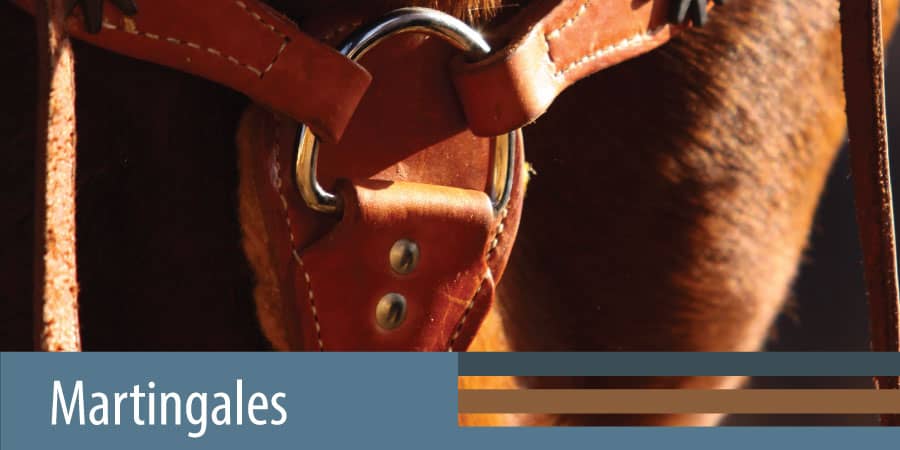
Function
There are many different types of martingales with different functions. A basic martingale’s main function is to help the rider keep the horse’s head in a lower position. The two straps of the martingale connect to the reins with rein stoppers on each.
When a horse pulls its head up, the martingale straps will pressure the reins, pulling downwards on the bit. The strap that runs around the horse’s neck can either be a plain loop or connect to the saddle’s D-rings. This can be used by the rider to hold onto when they lose balance, and if it connects to the saddle, it can help keep the saddle from slipping back.
There are three main designs for martingales – German, standing, and running martingales. Martingales are used as a form of protection and as a schooling aid.
Running martingales
The most basic martingale. It has a looped harness connected to the girth and an oval strap that goes around the horse’s neck. The two smaller straps are forked from the main harness and connect to the reins. The smaller straps are connected by metal rings that can run along with the reins freely.
The German or market harborough
This martingale looks similar to the running martingale. The fork straps run through each bit ring and attach to the reins.
Standing martingale
The standing martingale consists of a neck strap that runs around the neck, and another strap that attaches to the girth runs through the neck strap and connects to the back of the noseband.
Breastplates
A breastplate is a bit different from martingales. A five-point breastplate uses 5 points of attachment:
- To the girth
- Onto the D-rings of the saddle
- Underneath the girth buckles
A normal 3 point breastplate can be used in conjunction with a normal running martingale where the fork straps can clip onto the middle of the breastplate on the horse’s chest.
The main function of a breastplate is to keep the saddle in place while jumping.
Different kinds allowed in show jumping
Normal martingales that do not serve the function as running reins with one stopper on each rein are allowed in showjumping. The martingale must be unrestricted. The martingales may not be used as standing martingales—breastplates and martingales.
How these work
German or Market Harborough
The straps that run through each bit ring allow for much more control than a standard running martingale. It applies pressure directly to the bit and is a clearer aid in the horse’s mouth.
This martingale’s main use is as a training aid for horses that struggle to relax into the contact, flex at the poll, and collect.
This martingale is not allowed in competitions as it is used only as a training aid. It should also only be used with a snaffle bit.
Breastplates
Martingale attachments for the breastplates:
- Bib martingale: these straps are like normal martingale fork straps with a piece of triangular leather in the middle of the straps. It applies even pressure, keeps the reins parallel, and aids young or difficult horse’s in control and turning.
- Normal running martingale straps: it will not only help keep the saddle in place, but it also acts as a running martingale
- Elastic attachment: the straps that connect to the reins are elastic instead of leather.
Standing martinggales
Unlike the others, this martingale applies pressure directly onto the horse’s nose and does not apply any pressure to the bit or the horse’s mouth.
This was designed for horses that throw their heads up in the air and lifts their head very high. It becomes dangerous because the horse can hit the rider in the face or become out of control.
This is considered a last resort if a running martingale does not work. It must be used with a normal cavesson noseband.
It is a very restricting type of martingale and must be fitted and used properly as the horse can feel too restricted and uncomfortable.
Running matingales
This type of martingale works together with the bit. When the horse raises its head too high, the smaller straps apply pressure to the bit via the reins. This will encourage the horse to lower its head.
A horse that keeps its head very high and tends to speed up and run from the Rider’s hands into the jumps will benefit from a running martingale.
This martingale is considered safer than a standing martingale because the rider has more control over the constriction and release of the horse’s head movement.
For this martingale, it is imperative to use rein stoppers. This prevents the rings from running too high towards the bit and interferes with the bit and mouth.
Recommendations
Consult with your instructor before you choose a martingale. Know the reason why you want a martingale or breastplate and what you would like it to do. Make sure your horse is comfortable with the martingale and that it is allowed in the competition ring.
The design and quality of the martingale or breastplate are important. If you are looking for a martingale that matches your tack/bridle, I would recommend using the same brand as your bridle.
- Henri de Rivel
- Collegiate
- Mark Todd
- Horseware
- PS of Sweden
Girth
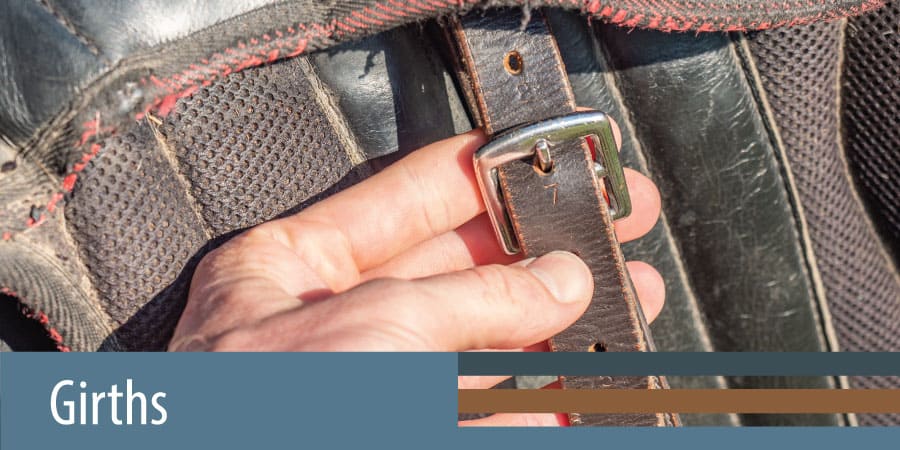
Function
The girth’s main and most important function is to keep the saddle in place and from slipping. The girth is a piece of leather or synthetic material attached to the saddle’s billets that pass underneath the horse (it should sit in the girth groove on the horse’s chest) and is attached on the other side of the saddle.
Girths have different designs and shapes, from plain and straight, to ergonomic to plated. The girth will either have a small buckle attachment in the middle for the martingale, or the girth will go through the loop at the end of the martingale to keep the martingale in place.
Different kinds allowed in show jumping
Any girth that is fitted properly, made of quality material, and comfortable for the horse is permitted. There are not any specific rules regarding girths.
How they work
The most commonly used girth in show jumping is the stud or plated girth. This girth is enlarged and circular in shape in the middle. It is usually made out of good quality and thick leather. The girth is also usually cut back behind the horse’s elbow to accommodate the movement of the legs and prevent chafing.
The enlarged part of the girth is mainly there the protect the horse’s chest area from being hit with their hooves or if the horse competes on grass, studs. This is most commonly seen in higher classes, where the horses tuck their front legs tightly underneath themselves.
This type of girth also has a small strap and buckle attachment in the middle of the enlarged part for the attachment of a martingale because it will not fit through the loop of the martingale.
Recommendations
As with the other above-mentioned tack, I will recommend a breathable, lightweight, and good quality girth. The girth needs to fit the horse properly and not interfere or chafe the elbows of the horse. The girth needs to be kept clean as it can irritate the skin.
Girths to look at on Amazon.com
Girths to look at on Horse.com
Stirrup leathers and irons
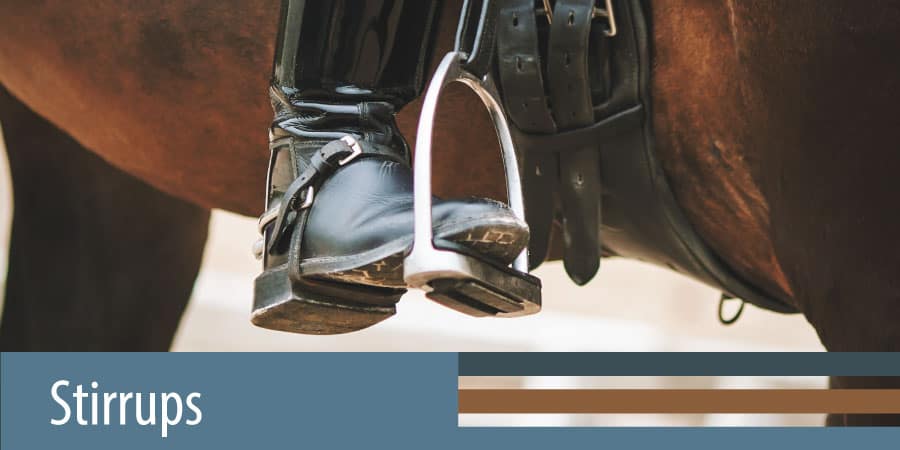
Function
Stirrup leathers and irons are used to keep the Rider’s legs in place, and the rider uses the stirrups to stand up in the saddle during jumping. The rider uses the stirrups to balance themselves and lighten their seat to take the weight off the horse’s back.
Leather stirrup straps are most commonly used along with metal, plastic, or aluminum stirrup irons. The leather straps are held onto the saddle by the stirrup bars under a small flap underneath the Rider’s leg. The stirrup leathers then hang down in a straight line and loop through the stirrup irons. The irons have different designs but mostly look similar.
The biggest difference is the plate on which the rider’s foot rests, and they may be angled. Some brands of stirrups are jointed on the sides to allow for more flexibility.
Different kinds allowed in show jumping
The only rule for stirrup leathers and irons, according to the FEI, is that the stirrup leather and irons must hang freely down the side of the saddle from the bar and not be attached anywhere else to the rider or saddle.
How these work
The stirrup leather only holds the stirrup iron attached to the saddle. The stirrup irons can have different designs.
The most basic design is the most seen and used stirrup irons. They are upside-down ‘U’ shaped stirrups with the base closing off the ‘U.’ These irons are usually made of stainless steel, and they are more affordable. The iron base is usually a thick rubber with a serrated pattern to improve the grip in the stirrup. These designs now come with safety options as well.
Angled and bigger base plate stirrups are increasing in popularity as it provides more support to the ball of the foot and helps the rider keep their heels down due to the angled base. The base is usually made of the same material as the whole iron and is not detachable.
The base can also be serrated or patterned to increase your grip and prevent your foot from slipping out. These irons are made of lightweight alloys or aluminum for added comfort.
Jointed stirrups take the basic design a bit further. The stirrup iron has a metal joint on each side of the iron that is then covered with rubber. This increases the stirrups’ mobility and comfort and allows the rider to move their ankles more freely while still keeping their weight in the stirrups.
Recommendations
These stirrups can be found on Amazon
These stirrups can be found on Horse.com
Boots
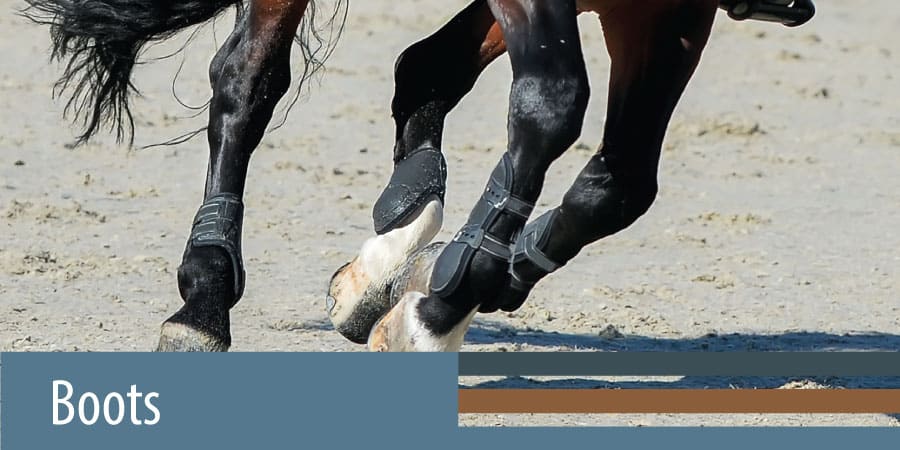
Function
Boots are used to protect the legs and the horse’s hooves from damage and injury caused by brushing, forging, or knocking the jumps. Brushing is caused by lateral gait abnormality due to conformation faults, such as toed out and narrow chests.
Uncoordinated and tired horses are also predisposed to brushing. Forging, speed cutting, shin hitting, and hock hitting happens when horses hit the front hoof with the back hoof or when the front hoof hits the back leg. This is caused by conformational faults and poor farriery.
Forging and scalping can cause serious damage where the hind hoof hits the front hoof either on the shoe or on the heel bulbs. This can cause the horse to lose a shoe or get an injury to the bulbs. When the front hoof hits the back leg, it can cause minor to major injuries in the hind leg.
Different kinds allowed in show jumping
The FEI recently posted new rules regarding the usage of boots in show jumping. It is a lengthy article, so I will summarize it. I would still highly recommend that you ensure that your boots are correct cording to the new rules.
There are now weight restrictions to the boots as well. The maximum weight allowed that includes boots on all four legs of the horse (all boots, excluding shoes) is 500 grams. Young horses have slightly different criteria than international and WEG rules.
For young horses: The hind boots are only allowed to have a protective shell on the inside of the fetlock. Wrap-around boots are not allowed. The length of the interior must not exceed 16 centimeters, and the width of the fasteners (straps) must not be smaller than 5 centimeters.
The hind boot extends to the pastern is allowed as long as it is soft and pliable. The inside must be smooth and be free of any pressure points. No additional objects may be inserted inside the boot.
For other events: boots with the protective shell on the inside and double-shell wrap-around boots are permitted. The maximum length of these boots allowed is 20 centimeters. The inside must be smooth as well. The boots are not allowed to have more than two fasteners. Velcro, stud and hook type fasteners are allowed; more dimensions and regulations on these fasteners are set out in the FEI Show Jumping rule book.
How these boots work
Brush boots and tendon boots
Brush and tendon boots are similar in design, but tendon boots are most widely used in show jumping because they have a harder outer shell and offer more protection. For the tendon boots, you get to the single shell or the double shell. The single-shell only protects the inside of the leg and fetlock, whereas the double-shell wraps around the back of the leg and protects the outside of the leg and fetlock.
Open front boots are preferred in show jumping as the pole will make contact with the horse’s leg instead of with the boot, giving the horse more pole awareness.
Overreach boots
Overreach boots are bell-shaped boots, usually made of rubber or thick material. These boots are designed to protect your horse from overreaching and knocking the front hoof with their back hoof and possibly pulling shoes or injuring themselves. The boot rests on the coronary band around the pattern and extends down over the hoof. The back of the hoof should be properly covered.
Fetlock rings
Fetlock rings are doughnut-shaped boots made from thick rubber. It lies just above the coronary band, and it is used to prevent the horse from scalping or to overreach onto the heel bulbs of the front hooves.
Recommendations
The boots are mostly up to the rider as they come in all shapes, sizes, and colors. One should look at boots that fit correctly, sit comfortably, and are designed according to the FEI rules and regulations.
Here are some of my favorites from Amazon
Here are some of my favorites from Horse.com







